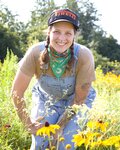By Margie O’loughlin
Marigolds, hollyhocks, cosmos, and black eyed Susans. These are just a few of the late-summer flowers bursting into bloom right now. While many are cutting them for bouquets, farmer Maddy Bartsch is steeping their petals, leaves, and seed heads in boiling water to produce a rainbow of natural dyes for yarn and fabric.
Bartsch is co-founder and president of Three Rivers Fibershed (TRF). A resident of southeast Minneapolis, they’ve been farming at Get Bentz Farm near Northfield for the last three years. They first started experimenting with natural dyes from plants grown in their south Minneapolis community garden plot and apartment window sill in 2016. Growing local color on a larger scale at Get Bentz Farm is their way of contributing to the local fibershed.
WHAT IS A FIBERSHED?
A fibershed develops regional, regenerative fiber systems through responsible carbon farming, rebuilding regional manufacturing, and connecting customers to farms and ranches through education and programming. The center of TRF is in Minneapolis, extending out in a 175-mile radius to include portions of Minnesota, Wisconsin, Iowa, and South Dakota.
Within a fibershed, fibers are considered from a soil-to-soil perspective. That means that fiber-bearing animals graze on local land as they grow their coats, instead of some faraway place. Items made from their fiber (sweaters, mittens, socks, etc.) are worn until the end of their durability and then composted – completing the soil-to-soil cycle.
Bartsch explained, “At TRF, we’re developing regional fiber systems that build soil and protect the health of our environment.” The goal is to create just, local economies that honor all participants: local labor, local fiber, and local natural dyes.
FIBER MOVEMENT GROWING
It wasn’t that many years ago that the organic food movement was considered fringe. Bartsch said, “As consumers, we’ve become much more aware of where our food comes from and how it’s grown. These same ideas can and should apply to what we wear. In general, people are learning more about the consequences of their clothing choices. People are realizing they don’t want to buy clothes that contain micro-plastics, and they care that synthetic fibers don’t break down in landfills.
“People are searching for products that mirror their values. We need to have as local a footprint as we can with what we wear. We need to make or purchase things that last, so we’re buying fewer pieces of clothing over time.”
GET TO KNOW YOUR FIBERSHED
The first step in understanding how a fibershed works is to get to know your own. Barstch shares a booth once each month with Northfield-based farmer/mill owner Theresa Bentz: Saturdays at the Mill City Farmers Market and Sundays at the Linden Hills Farmers Market. The two sell their yarn, natural dyes, and roving (thebundles of wool used by spinners to make yarn), among other things. Find them by looking in the market vendor listings for Get Bentz Farm.
Each month they have several products to sell that are reasonably priced, and can introduce customers to the soil-to-soil cycle. One of the products Bartsch sells is needle felted wool sponges made from “trash” wool that would otherwise end up in a landfill.
Everybody knows that wool comes from sheep, alpacas, llamas, and rabbits. But did you ever wonder what happens to the fiber of animals raised for meat? The animals have to be shorn before butchering, and their wool is typically thrown away. Bartsch uses it to make their biodegradable sponges – which, given the low price point of the wool, they can sell for just $6.
If you want to try your hand at working with natural fibers, consider taking one of the classes Bartsch teaches regularly at the American Swedish Institute on natural dyeing, mending, garment repair, and mindful stitching.
On Sept. 14, ASI is hosting Cocktails at the Castle from 6-11 p.m. At this event, Bartsch will be demonstrating how to make flower pounded felt coasters. Explore ASI’s historic Turnblad Mansion and festival grounds, featuring top local musicians, ASI’s first drag show, interactive art demos, make n’ takes, food, curated cocktails, and craft beers.
WHY NATURAL DYES?
The industrial manufacture of clothing destroys water systems with by-products of chemical dyeing and finishing processes, while consuming enormous amounts of water on a thirsty planet.
Bartsch said, “We’re working to build alternative models within our fibershed. These regional textile communities will improve soil and water quality, build relationships, and strengthen regional economies.
“Future fibershed communities will rely on renewable energy-powered mills in proximity to where fibers are grown. Through strategic grazing, conservation tillage, and soil carbon enhancing practices, our supply chains will create ‘climate beneficial’ clothing.
“In rethinking fashion, this has to become the standard for mitigating the effects of climate change. We see an emerging connection between the wearer and the local field where their clothes were grown.”
Bartsch teaches and speaks on the topic of local fiber systems and sustainable textiles to learners of all ages throughout the Midwest. They can be reached at
hello@threeriversfibershed.org.



Comments
No comments on this item Please log in to comment by clicking here